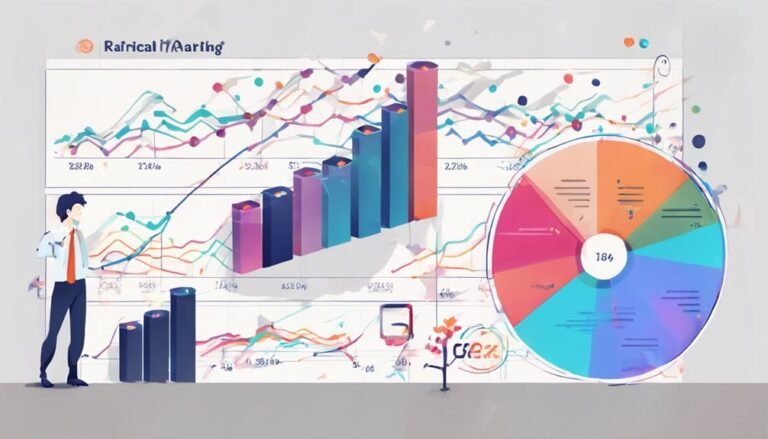How to Measure the Success of a Sales Campaign in Financial Services?
To measure the success of a sales campaign in financial services, you must analyze lead generation, conversion rates, customer acquisition costs, return on investment, sales pipeline, website traffic, email marketing, social media engagement, and competitor performance. Track key performance indicators like lead response time, conversion rates, cost per customer, and ROI for efficient assessment. Evaluate customer satisfaction, market trends, and lifetime value to enhance strategies. Utilize predictive analytics for thorough evaluation of long-term profitability and sales forecasting. Assess website traffic, email metrics, and social media engagement to optimize outreach. Analyze market share, industry trends, and competitor positioning for a detailed assessment.
Key Takeaways
- Track conversion rates and customer acquisition costs.
- Analyze ROI to evaluate campaign efficiency.
- Monitor sales pipeline stages and deal progression.
- Assess customer lifetime value and satisfaction levels.
- Utilize predictive analytics for long-term profit analysis.
Lead Generation Metrics
To effectively measure the success of a sales campaign in financial services, understanding and analyzing lead generation metrics is vital. Customer retention strategies and lead nurturing techniques play an essential role in optimizing these metrics.
Customer retention strategies focus on keeping existing clients engaged and satisfied, reducing churn rates, and increasing the lifetime value of customers. By implementing effective customer retention strategies, such as personalized communication and loyalty programs, financial service providers can enhance customer loyalty and boost referrals.
Lead nurturing techniques involve building relationships with potential customers at every stage of the sales funnel. This process requires personalized communication, timely follow-ups, and providing relevant information to address customer needs. By utilizing lead nurturing techniques, financial service companies can increase conversion rates and drive revenue growth.
Monitoring key metrics such as lead response time, conversion rates at each stage of the funnel, and customer acquisition costs can provide valuable insights into the effectiveness of lead generation efforts. Analyzing these metrics allows companies to make data-driven decisions and continually optimize their sales campaigns for better results.
Conversion Rate Analysis
Analyzing the conversion rates within your financial services sales campaign is essential to pinpoint areas for improvement and optimize performance. To enhance your conversion rates, consider implementing conversion rate optimization tactics and A/B testing strategies. By conducting A/B tests on different elements of your sales process, such as call-to-action buttons or email subject lines, you can identify which strategies yield the highest conversion rates and refine your approach accordingly.
Moreover, employing customer journey mapping can provide valuable insights into the various touchpoints a customer interacts with before making a purchase. Understanding the customer journey enables you to tailor your sales process to better meet their needs and increase conversion rates.
In addition, incorporating lead nurturing techniques, such as personalized follow-up emails or targeted content, can help move potential customers through the sales funnel more effectively.
Customer Acquisition Cost Calculation
Calculate the cost per customer meticulously and track your ROI diligently to gain valuable insights into the effectiveness of your sales campaigns. Understanding the customer acquisition cost allows you to make informed decisions on resource allocation and marketing strategies.
Cost per Customer
With a keen focus on operational efficiency, understanding the precise cost incurred to acquire each customer is paramount in evaluating the effectiveness of sales campaigns in the financial services sector. Calculating the cost per customer involves dividing the total expenses associated with acquiring customers by the number of customers gained during a specific period.
This metric is essential in evaluating the efficiency of marketing strategies and customer retention efforts. By analyzing the cost per customer, financial service companies can determine the effectiveness of their sales campaigns in attracting new clients while controlling acquisition costs.
Lower cost per customer values indicate higher marketing effectiveness and improved ROI, highlighting the importance of monitoring this metric closely to optimize sales campaign performance.
ROI Analysis
For a thorough evaluation of sales campaign success in financial services, delving into the ROI analysis through customer acquisition cost calculation is essential. By analyzing the ROI, you can gauge the effectiveness of your sales performance and marketing strategies.
Customer acquisition cost calculation allows you to determine how much it costs to acquire a new customer, providing vital insights into the efficiency of your campaigns. This analysis helps you understand the relationship between your spending on marketing efforts and the revenue generated from new customers.
A low customer acquisition cost indicates that your sales campaign is effective in acquiring new customers efficiently, contributing positively to your ROI. Monitoring this metric enables you to optimize your marketing strategies and enhance overall campaign performance.
Return on Investment (ROI) Measurement
When measuring the success of your sales campaigns in financial services, understanding the various methods for calculating ROI is essential.
By determining the ROI, you can gauge the effectiveness of your marketing efforts and make informed decisions for future campaigns.
Tracking campaign performance against ROI metrics allows you to optimize your strategies and allocate resources efficiently.
ROI Calculation Methods
How can you effectively measure the success of your sales campaigns in the financial services sector through robust ROI calculation methods?
To assess campaign effectiveness and sales performance, start by determining the revenue impact evaluation. Calculate the ROI by subtracting the campaign cost from the revenue generated, then divide by the cost and multiply by 100 to get the percentage return.
This method helps you understand the financial outcomes of your marketing strategy. Analyzing ROI provides insights into which campaigns are delivering the best results, allowing you to optimize future initiatives for higher returns.
Importance of ROI
Measuring the effectiveness of your sales campaigns in the financial services sector through robust Return on Investment (ROI) measurement is essential for optimizing future initiatives and maximizing returns.
When it comes to the importance of ROI, consider the following:
- Profitability Assessment: ROI helps in evaluating the profitability of your sales campaigns by comparing the gained profits to the campaign costs.
- Revenue Growth Tracking: It allows you to track the revenue growth generated by each campaign, enabling you to identify high-performing strategies.
- Resource Allocation: ROI analysis aids in determining where to allocate resources for future campaigns based on the most profitable approaches.
- Performance Evaluation: It provides a clear metric to evaluate the success of your sales campaigns and make data-driven decisions for future initiatives.
Tracking Campaign Performance
To optimize the effectiveness of your sales campaigns in the financial services sector, tracking campaign performance through robust Return on Investment (ROI) measurement is vital.
Campaign effectiveness evaluation is essential for understanding the impact of your marketing efforts. By utilizing performance measurement techniques such as tracking lead conversions, customer acquisition costs, and revenue generated from the campaign, you can gauge the success of your initiatives.
Calculating the ROI allows you to determine the profitability of each campaign, enabling you to allocate resources more efficiently in the future. Analyzing these metrics provides valuable insights into what strategies are working and what areas need improvement, ultimately helping you make data-driven decisions to enhance your sales performance in financial services.
Sales Pipeline Tracking
Effective sales pipeline tracking is crucial for accurately evaluating the progress and success of sales campaigns in the financial services industry. To guarantee you're effectively monitoring your sales pipeline, consider the following:
- Utilize CRM Systems: Implement Customer Relationship Management (CRM) systems to track customer interactions, lead progress, and sales opportunities. This allows for a centralized view of your sales pipeline.
- Define Clear Sales Stages: Establish distinct stages in your sales pipeline to categorize leads based on their position in the buying process. This enables better tracking and forecasting of potential conversions.
- Track Key Metrics: Monitor important metrics such as conversion rates, average deal size, and sales cycle length. Analyzing these metrics provides insights into the efficiency and effectiveness of your sales pipeline.
- Regularly Update and Review: Continuously update and review your sales pipeline to ensure accuracy and relevance. Regular maintenance helps in identifying bottlenecks and opportunities for sales funnel optimization.
Customer Lifetime Value Assessment
When evaluating customer lifetime value, it's vital to utilize various measurement methods to accurately gauge the value each customer brings to your financial services business.
Predictive analytics plays an important role in forecasting future customer behaviors and potential profitability, helping in making informed strategic decisions.
Long-term profit analysis based on customer lifetime value provides insights into the overall success and sustainability of sales campaigns in the financial services sector.
Value Measurement Methods
Customer Lifetime Value Assessment serves as a pivotal tool in determining the long-term profitability and strategic importance of individual customers in the financial services sector. When evaluating Customer Lifetime Value, consider the following:
- Customer Satisfaction Evaluation: Measure customer satisfaction levels to gauge loyalty and potential future revenue streams.
- Sales Team Feedback Analysis: Assess feedback from the sales team on customer interactions to identify patterns and opportunities.
- Market Trend Monitoring: Stay informed about market trends to adapt strategies and offerings accordingly.
- Industry Benchmark Comparison: Compare your performance against industry benchmarks to understand your position and identify areas for improvement.
Predictive Analytics Importance
Utilizing predictive analytics is essential for accurately evaluating Customer Lifetime Value in the financial services sector. Data-driven decisions are vital for understanding customer behavior, preferences, and potential profitability over the long term.
By leveraging predictive analytics, financial institutions can make informed business forecasts and tailor their strategies to maximize customer lifetime value. This analytical approach allows companies to identify high-value customers, predict their future needs, and personalize offerings to enhance customer satisfaction and retention.
Through predictive analytics, businesses can optimize marketing efforts, improve customer segmentation, and ultimately drive long-term profitability. Embracing predictive analytics not only enhances decision-making processes but also ensures that resources are allocated efficiently to maximize returns in the competitive financial services landscape.
Long-Term Profit Analysis
Implementing a thorough analysis of long-term profits through Customer Lifetime Value assessment is essential for financial institutions seeking to optimize strategic decision-making and enhance profitability. When evaluating the success of a sales campaign in financial services, focusing on long-term profit analysis is important. Here are four key aspects to take into account:
- Revenue Forecasting: Predicting future revenue streams based on customer lifetime value can guide resource allocation effectively.
- Profit Margin Analysis: Understanding the profit margins associated with different customer segments helps in tailoring marketing strategies for maximum profitability.
- Customer Retention Strategies: Developing initiatives to increase customer loyalty and lifetime value can have a significant impact on long-term profits.
- Investment Allocation: Utilizing Customer Lifetime Value data to allocate resources efficiently across marketing channels can enhance overall campaign success.
Website Traffic Analysis
Analyzing website traffic data provides valuable insights into the effectiveness of sales campaigns in financial services. By delving into metrics such as page views, unique visitors, bounce rates, and conversion rates, you can assess the impact of your strategies. When examining SEO optimization strategies, look at organic traffic growth, keyword rankings, and the quality of incoming traffic. A successful campaign should show an increase in organic visits due to improved search engine visibility.
Content marketing effectiveness can be evaluated by analyzing the performance of blog posts, articles, and other materials. Monitor metrics like time on page, social shares, and leads generated through content. High-quality, engaging content tends to attract more visitors and keep them on the site longer, potentially leading to more conversions.
Using tools like Google Analytics, you can track these key performance indicators over time, allowing you to make data-driven decisions to optimize your sales campaigns. By continuously monitoring and adjusting your strategies based on website traffic analysis, you can enhance the overall success of your financial services sales campaigns.
Email Marketing Performance Evaluation
Effective evaluation of email marketing performance is essential for gauging the impact of campaigns in the financial services sector. When analyzing email marketing effectiveness, consider the following key points:
- Open Rate Analysis: Monitor the percentage of recipients who open your emails. Low open rates may indicate issues with subject lines, sender credibility, or email timing.
- Click-Through Rate Evaluation: Examine the rate at which recipients click on links within your emails. A low click-through rate suggests the need for more engaging content or better placement of call-to-action buttons.
- A/B Testing Strategies: Implement A/B testing to compare different elements of your emails, such as subject lines, visuals, or CTAs. This method helps identify which variations perform better and can guide future optimization efforts.
- Content Optimization Techniques: Continuously refine your email content based on performance data. Tailor messages to resonate with your audience, include compelling visuals, and ensure clear and actionable information to enhance engagement and conversion rates.
Social Media Engagement Measurement
To accurately assess the impact of social media campaigns in the financial services industry, measuring social media engagement is vital. Engagement analytics play a significant role in determining the effectiveness of social media strategies. By utilizing social media monitoring tools, you can track metrics such as likes, shares, comments, and click-through rates to gauge how well your content resonates with your audience. These engagement analytics provide valuable insights into the level of interaction and interest generated by your posts.
Social media monitoring allows you to explore further into understanding the sentiments and preferences of your target demographic. By analyzing engagement metrics across different platforms, you can identify which channels are most effective in driving customer interactions and conversions. This data-driven approach enables you to refine your social media campaigns for best performance.
Competitor Analysis and Benchmarking
For a thorough understanding of your competitive landscape in the financial services sector, conducting in-depth competitor analysis and benchmarking is essential. To gain a competitive edge and evaluate the effectiveness of your sales campaigns, consider the following:
- Market Share Comparison: Analyze your market share relative to competitors to identify areas of strength and opportunities for growth.
- Competitor Positioning: Assess how your competitors position themselves in the market to differentiate your offerings effectively.
- Industry Trends Analysis: Stay updated on industry trends to adapt your strategies and stay ahead of the competition.
- Benchmarking Strategies: Implement benchmarking techniques to measure your performance against industry standards and identify areas for improvement.
Conclusion
To sum up, evaluating the success of a sales campaign in financial services is like maneuvering through a complex maze with precision and strategy. By examining lead generation metrics, conversion rates, customer acquisition costs, ROI, sales pipeline tracking, website traffic, email marketing performance, social media engagement, and competitor benchmarks, you can effectively assess the effectiveness of your campaign.
Remember, data-driven analysis is key to optimizing your sales efforts and achieving your financial goals.







